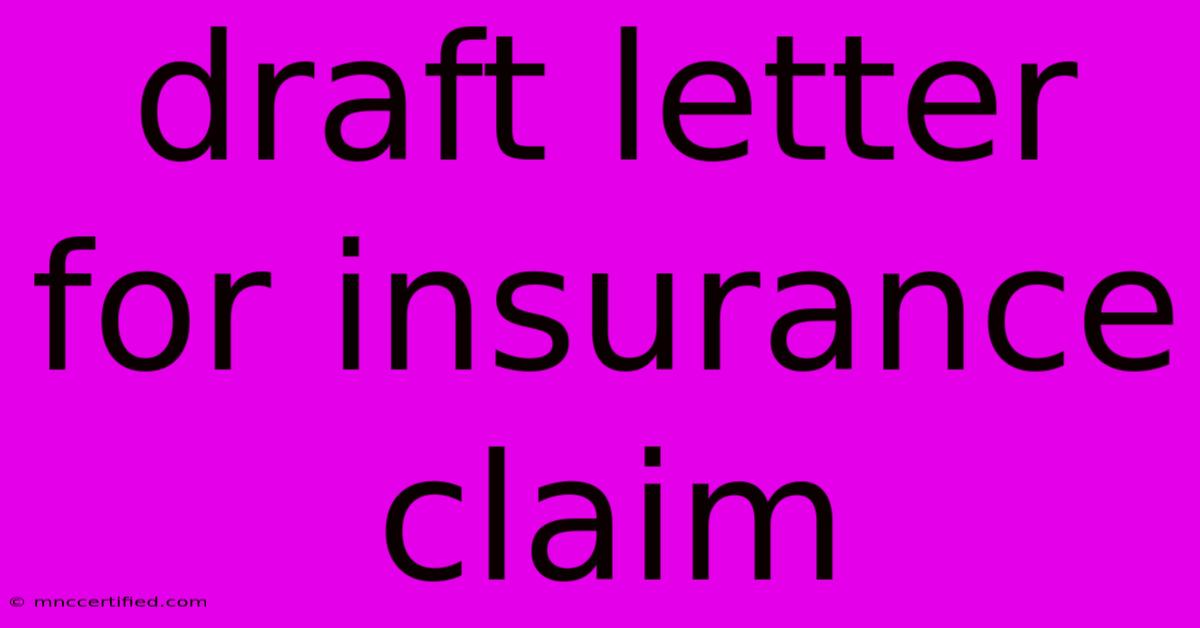Draft Letter For Insurance Claim

Table of Contents
Drafting the Perfect Insurance Claim Letter: A Step-by-Step Guide
Submitting an insurance claim can be stressful, but a well-crafted letter significantly increases your chances of a swift and successful resolution. This guide provides a step-by-step process for drafting a compelling insurance claim letter, ensuring you include all the necessary information and present your case effectively. We'll cover everything from the initial draft to ensuring your letter is optimized for a positive outcome.
Understanding the Importance of a Well-Written Claim Letter
Your insurance claim letter is your first formal communication with your insurance provider after an incident. A poorly written or incomplete letter can lead to delays, denials, or even the complete rejection of your claim. A clear, concise, and well-organized letter demonstrates your professionalism and commitment to resolving the matter efficiently. Think of it as your first impression – you want it to be a good one!
Key Elements of an Effective Insurance Claim Letter
Before we dive into the sample letter, let's outline the essential components:
- Your Contact Information: This includes your full name, address, phone number, and email address. Ensure this information is accurate and easily accessible.
- Policy Information: Your policy number is crucial. Include your policy type (e.g., homeowner's, auto, health) and the effective dates of coverage.
- Date of Incident: Clearly state the date the incident occurred. Be precise!
- Detailed Description of the Incident: This is the core of your letter. Provide a clear and concise account of what happened, including the time, location, and any contributing factors. Avoid emotional language; stick to factual details.
- List of Damages or Injuries: Specifically list all damages or injuries sustained. If applicable, provide details about the cost of repairs or medical treatment. Supporting documentation (photos, receipts, medical bills) strengthens your case.
- Claim Amount: State the total amount you are claiming. Support this figure with detailed evidence.
- Supporting Documentation: Mention any attachments you're including, such as photos, repair estimates, police reports, or medical bills.
- Your Request for Action: Clearly state what you want the insurance company to do. For example, "I request immediate processing of my claim and payment for the damages outlined above."
Sample Draft Letter for an Insurance Claim
Here's a sample draft you can adapt to your specific situation:
[Your Name] [Your Address] [Your Phone Number] [Your Email Address]
[Date]
[Insurance Company Name] [Insurance Company Address]
Subject: Insurance Claim – Policy Number [Your Policy Number]
Dear [Insurance Adjuster Name or To Whom It May Concern],
This letter is to formally file an insurance claim under my policy, number [Your Policy Number], for damages incurred on [Date of Incident].
On [Date of Incident], at approximately [Time of Incident], [Briefly describe the incident – what happened, where, etc.]. [Provide more detailed explanation of the incident, including who was involved and any witnesses].
As a result of this incident, I have incurred the following damages: [List damages clearly and concisely, providing specific details and costs wherever possible. E.g., "Damage to front bumper: $500 (Estimate attached); Replacement of broken headlight: $200 (Receipt attached); Medical bills: $1000 (Medical bills attached)."].
I have attached the following supporting documentation:
- Photos of the damage
- Repair estimate from [Repair Shop Name]
- Police report (if applicable)
- Medical bills (if applicable)
The total cost of damages is [Total Claim Amount]. I request immediate processing of my claim and payment for the damages outlined above. Please contact me at [Your Phone Number] or [Your Email Address] if you require any further information.
Sincerely, [Your Signature] [Your Typed Name]
Optimizing Your Letter for a Positive Outcome
- Proofread Carefully: Errors in grammar and spelling undermine your credibility.
- Keep it Concise: Avoid unnecessary jargon or lengthy explanations.
- Maintain a Professional Tone: Even if you're frustrated, maintain a professional and respectful tone throughout the letter.
- Follow Up: If you haven't heard back within a reasonable timeframe, follow up with a phone call or a polite email.
By following these steps and using the sample letter as a guide, you can create a strong and effective insurance claim letter that significantly improves your chances of a successful claim. Remember, clarity, accuracy, and thorough documentation are key. Good luck!

Thank you for visiting our website wich cover about Draft Letter For Insurance Claim. We hope the information provided has been useful to you. Feel free to contact us if you have any questions or need further assistance. See you next time and dont miss to bookmark.
Featured Posts
-
Watch Cavaliers Vs Pelicans Game
Nov 21, 2024
-
Lawyer Against Insurance Company
Nov 21, 2024
-
Lapse In Home Insurance Coverage
Nov 21, 2024
-
Does Insurance Cover False Teeth
Nov 21, 2024
-
Navy Mutual Life Insurance Rates
Nov 21, 2024